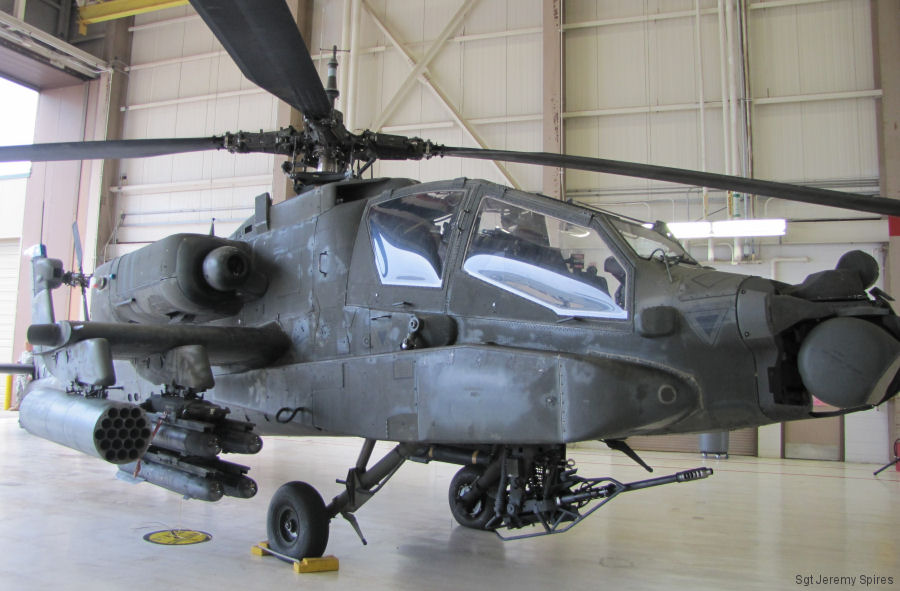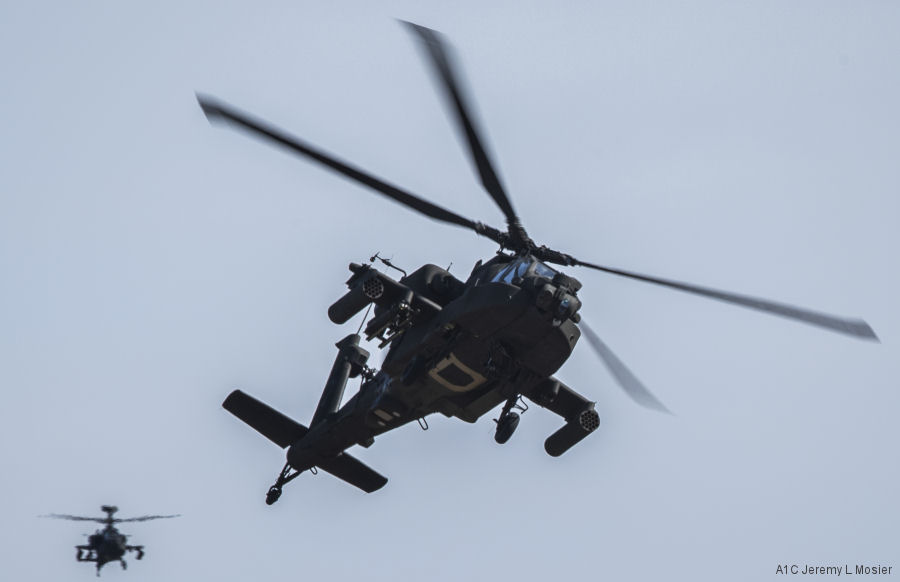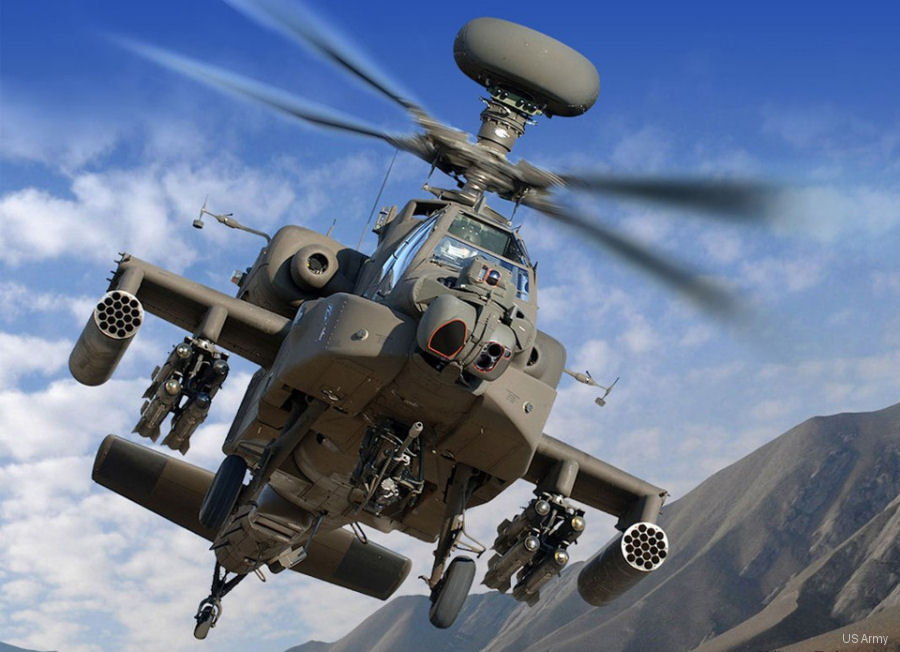
The Apache has been the Army’s heavy attack helicopter since the first delivery in January 1984. As the Project Management (PM) Office for Apache and the Army’s Aviation enterprise marks the 40th anniversary of the first delivery, Apache helicopters remain on duty around the globe, protecting America’s interests, and will continue in that role for the foreseeable future. To date, more than 5,000 AH-64 aircraft have been delivered to the U.S. Army and 18 international partners and allies.
PM Apache has steadily upgraded the Apache from its original configuration. Few components of that first design remain, and the upgrades have produced the world’s premier attack helicopter. The PM released the latest version of the Apache in 2020.
“We’re extremely proud of the weapon system and the progression of capability over the years,” Col. Jay Maher, Apache project manager, said. “The Apache of today integrates the latest technologies, and we've been forging a roadmap for technological growth that lets us incorporate new capability aligned with Army priorities.”
The Apache, which replaced the Vietnam era AH-1 Cobra, has been a valuable tool in the Army’s arsenal in both supporting Army ground forces and battle plans, as well as strategic attacks into enemy rear areas to support Army objectives. In Desert Storm, the Apache was used to fly deep into Iraq to destroy enemy radar facilities as the opening salvo to initiate the US and Coalition forces fight to free Kuwait. During Operation Enduring Freedom/ Operation Iraqi Freedom, Apaches were used to provide convoy escorts and support ground forces in contact.
The Apache has over 1,340,000 flight hours in combat and peace-keeping operations in Afghanistan, Kuwait, Iraq, and surrounding areas.
The Apache PM continues to innovate and improve the capabilities, sustainment, safety, and maintainability of the Apache for pilots and maintainers.
“Our priority is to provide Warfighters with the necessary capabilities to be successful on tomorrow’s battlefield,” Maher said. “We are proud of the Apache and all those who maintain and employ the world’s premiere attack helicopter.”

Apache variants
AH-64A The AH-64A is the original production attack helicopter. The crew sits in tandem in an armored compartment. It is powered by two GE T700 turboshaft engines. The A-model was equipped with the −701 engine version until 1990 when the engines were switched to the more powerful −701C version. U.S. Army AH-64As are being converted to AH-64Ds. The service's last AH-64A was taken out of service in July 2012 before conversion at Boeing's facility in Mesa, Arizona. On 25 September 2012, Boeing received a $136.8M contract to remanufacture the last 16 AH-64As into the AH-64D Block II version and this was forecast to be completed by December 2013.
AH-64B In 1991, after Operation Desert Storm, the AH-64B was a proposed upgrade to 254 AH-64As. The upgrade would have included new rotor blades, a Global Positioning System (GPS), improved navigation systems and new radios. U.S. Congress approved $82M to begin the Apache B upgrade. The B program was canceled in 1992. The radio, navigation, and GPS modifications were later installed on most A-model Apaches through other upgrades.
AH-64C Additional funding from Congress in late 1991 resulted in a program to upgrade AH-64As to an AH-64B+ version. More funding changed the plan to upgrade to AH-64C. The C upgrade would include all changes to be included in the Longbow except for mast-mounted radar and newer −700C engine versions. However, the C designation was dropped after 1993. With AH-64As receiving the newer engine from 1990, the only difference between the C model and the radar-equipped D model was the radar, which could be moved from one aircraft to another; thus the decision was made to simply designate both versions "AH-64D".
AH-64D The AH-64D Apache Longbow is equipped with a glass cockpit and advanced sensors, the most noticeable of which being the AN/APG-78 Longbow millimeter-wave fire-control radar (FCR) target acquisition system and the Radar Frequency Interferometer (RFI), housed in a dome located above the main rotor. The radome's raised position enables target detection while the helicopter is behind obstacles (e.g. terrain, trees or buildings). The AN/APG-78 is capable of simultaneously tracking up to 128 targets and engaging up to 16 at once; an attack can be initiated within 30 seconds. A radio modem integrated with the sensor suite allows data to be shared with ground units and other Apaches, allowing them to fire on targets detected by a single helicopter. The aircraft is powered by a pair of uprated T700-GE-701C engines. The forward fuselage was expanded to accommodate new systems to improve survivability, navigation, and 'tactical internet' communications capabilities. In February 2003, the first Block II Apache was delivered to the U.S. Army, featuring digital communications upgrades. The Japanese Apache AH-64DJP variant is based on the AH-64D; it can be equipped with the AIM-92 Stinger air-to-air missiles for self-defense.
AH-64E Formerly known as AH-64D Block III, in 2012, it was re-designated as AH-64E Guardian to represent its increased capabilities. The AH-64E features improved digital connectivity, the Joint Tactical Information Distribution System, more powerful T700-GE-701D engines with upgraded face gear transmission to accommodate more power, capability to control unmanned aerial vehicles (UAVs), full IFR capability, and improved landing gear. New composite rotor blades, which successfully completed testing in 2004, increase cruise speed, climb rate, and payload capacity. Deliveries began in November 2011. Full-rate production was approved on 24 October 2012, with 634 AH-64Ds to be upgraded to AH-64E standard and production of 56 new-build AH-64Es to start in 2019/20. Changes in production lots 4 through 6 shall include a cognitive decision aiding system and new self-diagnostic abilities. The updated Longbow radar has an oversea capacity, potentially enabling naval strikes; an AESA radar is under consideration. The E model is to be fit for maritime operations. The Army has expressed a desire to add extended-range fuel tanks to the AH-64E to further increase range and endurance. AH-64Es are to have the L-3 Communications MUM-TX datalink installed in place of two previous counterparts, communicating on C, D, L, and Ku frequency bands to transmit and receive data and video with all Army UAVs. Lots 5 and 6 will be equipped with Link 16 data-links. As of April 2020, 500 AH-64E have been delivered.
AH-64F In 2014, Boeing conceptualized an Apache upgrade prior to the introduction of the U.S. Army's anticipated attack version of the Future Vertical Lift (FVL) aircraft, forecast to replace the Apache by 2040. The conceptual AH-64F would have greater speed via a new 3,000 shp turboshaft engine from the Improved Turbine Engine Program, retractable landing gear, stub wings to offload lift from the main rotor during cruise, and a tail rotor that can articulate 90 degrees to provide forward thrust. In October 2016, the Army revealed they would not pursue another Apache upgrade to focus on funding FVL; the Army will continue buying the Apache through the 2020s until Boeing's production line ends in 2026, then FVL is slated to come online in 2030.
Compound Apache In October 2018, Boeing began testing the AH-64E Block 2 Compound, a compound helicopter design which added a larger fixed wing and a pusher propeller to the Apache airframe to provide additional lift and thrust, respectively. In addition, the engine exhaust was redirected downwards. Collectively, the modifications were anticipated to improve speed to 185 kn (343 km/h; 213 mph), range to 460 nmi (850 km; 530 mi), payload to 5,900 lb (2,700 kg), and fuel economy. A 30% scale model completed wind tunnel testing in January 2019. The Compound Apache has been pitched as an interim replacement for the Apache before its replacement under the Future Vertical Lift program.
Sea Apache During the 1980s naval versions of the AH-64A for the United States Marine Corps and Navy were examined. Multiple concepts were studied with altered landing gear arrangements, improved avionics and weapons. The USMC was very interested and conducted a two-week evaluation of the Apache in September 1981, including shipboard operation tests. Funding for a naval version was not provided; the Marine Corps continued to use the AH-1. The Canadian Forces Maritime Command also examined a naval Apache. In 2004, British Army AgustaWestland Apaches were deployed upon the Royal Navy's HMS Ocean, a Landing Platform Helicopter, for suitability testing; there was U.S. interest in the trials. During the 2011 military intervention in Libya, the British Army extensively used Apaches from HMS Ocean. In 2013, U.S. 36th Combat Aviation Brigade AH-64Ds were tested on a variety of U.S. Navy ships.
Export Apaches Several models have been derived from both AH-64A and AH-64D for export. The British-built AgustaWestland Apache (assembled from kits purchased from Boeing) is based on the AH-64D Block I with several different systems, including more powerful engines, folding rotor blades, and other modifications for operation from Royal Navy vessels.

Boeing AH-64E Apache Guardian
See also |
AH-64E Apache in
AH-64D Apache in
AH-64A Apache in




